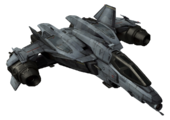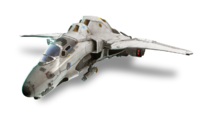Space fighter: Difference between revisions
From Halopedia, the Halo wiki
CMDR RileySV (talk | contribs) (Reworked the page to be more consistent and have more information.) |
BaconShelf (talk | contribs) |
||
| Line 5: | Line 5: | ||
These ships are unable to enter [[slipspace]] by themselves, and need to be launched from planetary bases, orbiting [[space station]]s, or [[capital ship]]s to conduct ''strike''-operations against enemy [[warship]]s, intercept fighters, and provide escort for warships and [[dropship]]s.<ref>''[[Halo Encyclopedia]]'', p. 266</ref><ref>''[[Halo: First Strike]]'', p. 6</ref> Their size varies from a few meters to well over 50 meters. Most known space fighters are [[Wikipedia:Spaceplane|spaceplanes]], capable of operating in both atmospheric/exoatmospheric (A/X) and suborbital/orbital (S/O) environments. The [[Forerunner]] [[Warrior-Servant]]s often used space fighters in combat. Some space fighters, called [[weapon-ship]]s, could be remotely-controlled at a ratio of up to a million ships per warrior.<ref>''[[Halo: Cryptum]]'', p. 174</ref> | These ships are unable to enter [[slipspace]] by themselves, and need to be launched from planetary bases, orbiting [[space station]]s, or [[capital ship]]s to conduct ''strike''-operations against enemy [[warship]]s, intercept fighters, and provide escort for warships and [[dropship]]s.<ref>''[[Halo Encyclopedia]]'', p. 266</ref><ref>''[[Halo: First Strike]]'', p. 6</ref> Their size varies from a few meters to well over 50 meters. Most known space fighters are [[Wikipedia:Spaceplane|spaceplanes]], capable of operating in both atmospheric/exoatmospheric (A/X) and suborbital/orbital (S/O) environments. The [[Forerunner]] [[Warrior-Servant]]s often used space fighters in combat. Some space fighters, called [[weapon-ship]]s, could be remotely-controlled at a ratio of up to a million ships per warrior.<ref>''[[Halo: Cryptum]]'', p. 174</ref> | ||
[[Warship]]s primarily designed to transport and maintain fighter-squadrons are commonly known as [[carrier]]s.<ref>''Halo Encyclopedia'', p. 259</ref> In the [[UNSC Navy]], starfighters were deployed from all warships larger than a [[UNSC corvette|corvette]], as corvettes were too small to carry anything larger than a shuttle.<ref>''[[Halo: Contact Harvest]]'', p. 64</ref> | [[Warship]]s primarily designed to transport and maintain fighter-squadrons are commonly known as [[carrier]]s.<ref>''Halo Encyclopedia'', p. 259</ref> In the [[UNSC Navy]], starfighters were deployed from all warships larger than a [[UNSC corvette|corvette]], as corvettes were too small to carry anything larger than a shuttle.<ref>''[[Halo: Contact Harvest]]'', p. 64</ref> {{Class|Marathon|heavy cruiser}}s are capable of reconfiguring themselves as light carriers by sacrificing weapons installations and cargo bays for increased fighter capacity.<ref name="fb125">''[[Halo: Fleet Battles]]'', Core Rulebook - p.125</ref> UNSC doctrine typically dictates the launching of a fighter assault against an enemy fleet employing wolf-pack tactics before it can swarm a [[capital ship]].<ref name="SS17">''[[Halo: Silent Storm]]'', Chapter 17</ref> | ||
The Covenant typically deployed their fighters During the [[Battle of Biko]], [[Nizat 'Kvarosee]] deployed his fighters in a tight "shell" around their motherships, ensuring that any attempt to [[Boarding|board]] his vessels would be met with failure, considered an unusual deployment tactic by the UNSC.<ref name="SS17"/> This differed from usual Covenant deployment tactics, which would see fighters deploy straight to attack the enemy, leaving their capital ships relatively undefended.<ref name="SS21">''Halo: Silent Storm'', Chapter 21</ref> | |||
==Types== | ==Types== | ||
Revision as of 19:55, March 8, 2020
A space fighter,[1], strike fighter,[2][3] or simply fighter,[2][3][4] known by the Covenant as Strikecraft[5][6] and to the UNSC as an interceptor,[7][3] are small, versatile, and maneuverable spacecraft, primarily used for exoatmospheric interception, interdiction, or space-supremacy operations.
Summary
These ships are unable to enter slipspace by themselves, and need to be launched from planetary bases, orbiting space stations, or capital ships to conduct strike-operations against enemy warships, intercept fighters, and provide escort for warships and dropships.[8][9] Their size varies from a few meters to well over 50 meters. Most known space fighters are spaceplanes, capable of operating in both atmospheric/exoatmospheric (A/X) and suborbital/orbital (S/O) environments. The Forerunner Warrior-Servants often used space fighters in combat. Some space fighters, called weapon-ships, could be remotely-controlled at a ratio of up to a million ships per warrior.[10]
Warships primarily designed to transport and maintain fighter-squadrons are commonly known as carriers.[11] In the UNSC Navy, starfighters were deployed from all warships larger than a corvette, as corvettes were too small to carry anything larger than a shuttle.[12] Marathon-class heavy cruisers are capable of reconfiguring themselves as light carriers by sacrificing weapons installations and cargo bays for increased fighter capacity.[13] UNSC doctrine typically dictates the launching of a fighter assault against an enemy fleet employing wolf-pack tactics before it can swarm a capital ship.[14]
The Covenant typically deployed their fighters During the Battle of Biko, Nizat 'Kvarosee deployed his fighters in a tight "shell" around their motherships, ensuring that any attempt to board his vessels would be met with failure, considered an unusual deployment tactic by the UNSC.[14] This differed from usual Covenant deployment tactics, which would see fighters deploy straight to attack the enemy, leaving their capital ships relatively undefended.[15]
Types
Covenant
- Type-27 Banshee - An exoatmospheric variant of the Type-26 Banshee,[16] it was the standard interceptor support craft of the Covenant fleet.[17]
- Seraph - Seraph is the name of several different space fighters.[18] Two design patterns of that fall under it are the Morsam-pattern (known as the Type-31 Seraph) and the Kai-pattern.
- Tarasque heavy fighter - The Tarasque heavy fighter was an older space fighter.[19]
- Gigas fighter-bomber - The Gigas fighter-bomber was an older craft.[19] Though it still saw deployment as late as 2526 from the Fleet of Swift Justice.[20]
Human
- GA-TL1 Longsword - The primary fighter of the UNSC fleet.[21] Two known variants of the Longsword exist including the C709 Longsword and the C712 Longsword.
- YSS-1000 Sabre - The Sabre is a swift, versatile, and utterly lethal interceptor. Only several hundred were manufactured before the war ended.[7] It could launch from the surface of a planet via a single-stage-to-orbit system.[16]
- F-41 Broadsword - The Broadsword was a type of UNSC interceptor manufactured in the thousands primarily in the Outer Colonies during the Covenant war.[3]
- OF92 Booster Frame - The OF92 Booster Frame is a type of open frame space fighter designed for Spartan operatives.[1]
- S-14 Baselard - The Baselard was a two-seater fighter craft in use by the UNSC as early as 2526.[22]
- Nandao fighter - The Nandao fighter was a type of fighter used by the UNSC as early as 2526.[23]
Forerunner
- Despair-class fighter - The Despair-class fighter was a Forerunner fighter that was buildable from a ship-seed.[4]
Gameplay
Halo: Reach
During the level Long Night of Solace, the player has the opportunity to fly the YSS-1000 Sabre over Reach.
Halo 4
In the final level Midnight, the player is given the opportunity to fly the F-41 Broadsword through the Forerunner ship Mantle's Approach.
Sources
- ^ a b Halo: Warfleet, Frigates, p. 38
- ^ a b Halo 4: The Essential Visual Guide, p. 114
- ^ a b c d Halo: Warfleet, Fighters, p. 28-29
- ^ a b Halo Wars 2, Phoenix Logs, Forerunner ship
- ^ Halo: Warfleet, Glossary, p. 92
- ^ Halo: Warfleet, Strikecraft, p. 58-59
- ^ a b Halo: Warfleet, Carriers, p. 40
- ^ Halo Encyclopedia, p. 266
- ^ Halo: First Strike, p. 6
- ^ Halo: Cryptum, p. 174
- ^ Halo Encyclopedia, p. 259
- ^ Halo: Contact Harvest, p. 64
- ^ Halo: Fleet Battles, Core Rulebook - p.125
- ^ a b Halo: Silent Storm, Chapter 17
- ^ Halo: Silent Storm, Chapter 21
- ^ a b Halo: Reach, campaign level, Long Night of Solace
- ^ Halo: Reach, game stats
- ^ Halo: The Essential Visual Guide, p. 169
- ^ a b Halo 3 - Appearance - Armor - Armor Classification: Elite - Head - Flight description
- ^ Halo: Oblivion, Chapter 21
- ^ Halo Encyclopedia: The Definitive Guide to the Halo Universe, p. 261
- ^ Halo: Silent Storm, Chapter 19
- ^ Halo: Oblivion, Chapter 12
| ||||||||||||||








